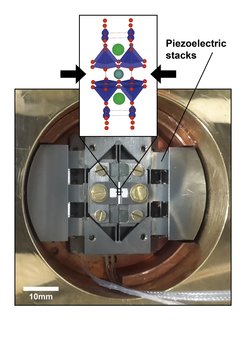High pressure orders electrons
Superconductors transport electricity without losses, and therefore do not exhibit any electrical resistance below certain temperatures. However, they are dependent on extremely low temperatures: Classic superconductors have to be cooled down almost to absolute zero - minus 273 degrees Celsius. Even the so-called high-temperature superconductors still require temperatures of about minus 200 degrees Celsius to conduct electricity without resistance. Despite the elaborate cooling technology that is required, superconductors are already used in various areas. In order to develop superconductors that work at higher temperatures, possibly even at room temperature, the critical states and processes in superconducting materials need to be understood fundamentally.
In an international collaboration, researchers from the Max Planck Institute for Solid State Research in Stuttgart, the European Synchrotron Radiation Facility (ESRF) in Grenoble/France, the Max Planck Institute for Chemical Physics of Solids in Dresden, the Karlsruhe Institute of Technology ( KIT) and the Universidad Nacional de La Plata/Argentina have taken a major step forward in this regard: They have shown that high uniaxial pressure can control competing states in a high temperature superconductor. A publication in the journal Science presents the results.
Using high-resolution inelastic X-ray scattering - which measures the scattered light from incoming X-rays on a sample - the scientists investigated the high-temperature superconductor YBa2Cu3O6.67. The material belongs to the so-called cuprates and is a complex compound of copper, oxygen and other elements. Copper and oxygen atoms form two-dimensional layered structures (see figure). If additional charge carriers are introduced into these layers, complex and competing states occur: The coupling between charge carriers leads to superconductivity, whereas a rigid charge order prevents them. Charge order is the formation of stripe-shaped nanostructures of the additional charge carriers, which makes them immobile and thus suppresses superconductivity. Periodic fluctuations in the distribution of electric charges, known as charge density waves (CDW), also prevent superconductivity. Chemical substitutions, called doping, or external magnetic fields can be used to vary these conditions. The interpretation of such experiments, however, is hampered by lattice defects and random magnetic vortices.
On the other hand, uniaxial pressure allows a precise investigation of the relationship between charge density waves and superconductivity. Working with pressure apparatus designed and built at the Max Planck Institute for Chemical Physics of Solids in Dresden, the researchers showed in their investigations that high pressure along a crystal axis in the cuprate layers of the investigated high-temperature superconductor YBa2Cu3O6.67 leads to a long-range three-dimensional charge density wave state, without the need for an external magnetic field. The results provide new, detailed insights into the function of high temperature superconductors and other electronically correlated materials. In addition, they show that uniaxial pressure allows to control the order of the electrons in such materials.
HR, AM / CPfS

